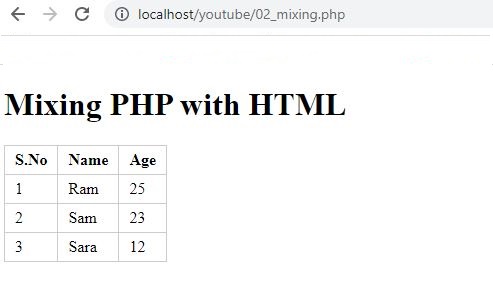Seamless Integration: Mixing PHP with HTML in PHP Web Development
Mixing PHP with HTML in PHP web development involves embedding PHP code within HTML code to create dynamic web pages. PHP, being a server-side scripting language, allows developers to write PHP code within HTML files, which is then executed on the server side before sending the HTML output to the client's web browser. This allows for dynamic content generation and customization of web pages based on user input or other conditions.
To mix PHP with HTML, you can use PHP tags (<?php ?>) within an HTML file to enclose PHP code.For Example
<h1>Hello, <?php echo "Welcome to Tutor Joes!"; ?></h1>
In the above example, PHP code is embedded within the HTML file using (<?php ?>) tags. The PHP code echo statements are used to output dynamic content within the HTML markup. The PHP code is executed on the server side, and the resulting HTML output is sent to the client's web browser.
Its allows for dynamic content generation, data processing, form handling, and other server-side functionalities. It enables developers to create dynamic and interactive web pages that can adapt to user input, retrieve data from databases, and perform various operations on the server side to generate personalized content for website visitors. Properly mixing PHP with HTML requires an understanding of PHP syntax, HTML markup, and best practices for separation of concerns to maintain clean and maintainable code.
Sample Code
<!DOCTYPE html> <html lang="en"> <head> <meta charset="UTF-8"> <meta http-equiv="X-UA-Compatible" content="IE=edge"> <meta name="viewport" content="width=device-width, initial-scale=1.0"> <title>Mixing PHP with HTML</title> </head> <style> table{ border: 1px solid #ccc; border-collapse: collapse; } td,th{ border: 1px solid #ccc; padding:5px 10px; } </style> <body> <h1>Mixing PHP with HTML</h1> <table> <thead> <tr> <th>S.No</th> <th>Name</th> <th>Age</th> </tr> </thead> <tbody> <tr> <td>1</td> <td>Ram</td> <td>25</td> </tr> <?php echo " <tr> <td>2</td> <td>Sam</td> <td>23</td> </tr> "; ?> <tr> <td>3</td> <td>Sara</td> <td>12</td> </tr> </tbody> </table> </body> </html>
The second row of data is generated dynamically using PHP. Inside PHP tags (<?php ?>), an echo statement is used to output HTML code that defines the second row of the table.
The PHP code includes a multi-line string that contains the HTML markup for the row, including the data for each cell. The PHP code is executed on the server side and the resulting HTML output is sent to the client's web browser.
Output

This example demonstrates how PHP can be mixed with HTML to dynamically generate HTML output based on server-side logic, allowing for dynamic content generation and customization in web pages
List of Programs
Learn All in Tamil © Designed & Developed By Tutor Joes | Privacy Policy | Terms & Conditions